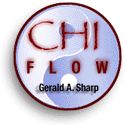Liangong
in 18 FORMS: "Inside China's Emerging Exercise Phenomenon"
by Gerald A. Sharp
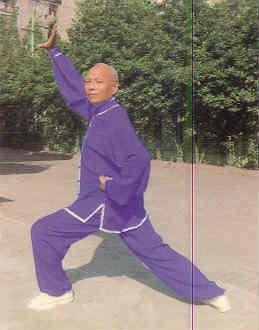
(Author's Note: The following text is meant to serve as basic information on Liangong in 18 Forms. An article by the author was published in Volume 12, No. 2, Summer 2002 issue of Qi Journal. You can access the article or obtain a copy through the website at: http://www.qi-journal.com/) See also www.Liangong.com.
For centuries martial artists have known that their forms and training regimens have helped relieve stress and provide medicine through movement. However, what's still lacking is ample scientific evidence to support the many benefits of such exercises or scientific testing to further develop the exercises to address specific problems and combat more modern forms of stress.
In 1974, Dr. Zhuang Yuan Ming (1919- ), a prominent Doctor of Traumatology (a Traditional Branch that focuses on healing external and internal discomfort and stress) and a top student of the famous Kung Fu Master, Wang Zhiping, began developing a set of exercises which became known as Liangong in 18 forms. The original 18 exercises (now their are 54) focused on combating and overcoming acute pain and stress in the neck, shoulders, back, legs, joints, and connective tissue.
Liangong's roots are based on Traditional Chinese Chi Kung and Kung Fu. While authentic Liangong may be relatively new in America, Liangong has garnered an international audience, with the largest body of practitioners outside of China residing in Japan. But what do the Japanese and other martial arts practitioners world-wide see in the practice of Liangong in 18 forms?
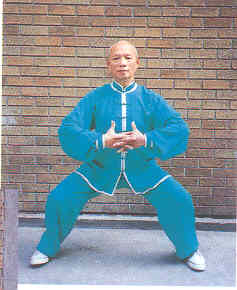 While the development of Liangong may have officially begun in 1974, Dr. Zhuang's curiosity for health and healing began over 25 years prior as a student of the legendary Wang Zhiping. Using exercises he had studied with Wang, known as the "20 Exercises," and the ancient exercises of Daoyin (Breathing Exercise), Baduanjing (Eight Pieces of Brocade), and Yijinjing (Muscle Change Classic), Zhuang tested all these exercises in a prominent Shanghai hospital on patients with a variety of stress related conditions to determine how effective these exercises were clinically, and what modifications, if any, could be made to bring about more favorable results treating stress related problems and diseases by utilizing exercise exclusively. As a student of Wang, a young Dr. Zhuang saw his teacher use a variety of massage techniques and exercises to heal a variety of afflictions. Wang may have had a reputation as a tough, no-nonsense guy, but Zhuang observed a more sensitive side of Wang and relates how Wang was fixated with the power of healing and maintaining health.
While the development of Liangong may have officially begun in 1974, Dr. Zhuang's curiosity for health and healing began over 25 years prior as a student of the legendary Wang Zhiping. Using exercises he had studied with Wang, known as the "20 Exercises," and the ancient exercises of Daoyin (Breathing Exercise), Baduanjing (Eight Pieces of Brocade), and Yijinjing (Muscle Change Classic), Zhuang tested all these exercises in a prominent Shanghai hospital on patients with a variety of stress related conditions to determine how effective these exercises were clinically, and what modifications, if any, could be made to bring about more favorable results treating stress related problems and diseases by utilizing exercise exclusively. As a student of Wang, a young Dr. Zhuang saw his teacher use a variety of massage techniques and exercises to heal a variety of afflictions. Wang may have had a reputation as a tough, no-nonsense guy, but Zhuang observed a more sensitive side of Wang and relates how Wang was fixated with the power of healing and maintaining health.
SCIENCE AND LIANGONG
In the 1970's, Dr. Zhuang was afforded the opportunity to develop and test Liangong in 18 Forms at the Huangpu Hospital in Shanghai. According to Zhuang, he kept an open mind about his preconceptions of what would or would not work.If this was to be a true experiment, one cannot go into it and say these are the results that I want, and presto they happen. However, he was confident that exercise would be effective in the healing process, but was unsure as to what degree or effect exercise would have. He wanted to move beyond a one size fits all concept. So he kept specific records of what worked and what didn't. Then regularly a variety of modifications were added to the traditional exercises to determine what would actually lead to more feeling or complete alleviation of a problem.
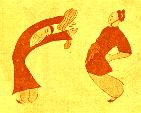
 During the infant stages of Liangong's development, from 1974 through 1975, Dr. Zhuang became fascinated with ancient drawings, that had been recently unearthed from Han Dynasty tombs on the outskirts off Changsha, Hunan Province by archaeologists. These silk scroll figure drawings were of exercises known as Daoyin (or, breathing exercises). One of the first things Dr. Zhuang noticed was the similarity between these ancient drawings and the "20 Exercises" he had studied with Wang Zhiping.
During the infant stages of Liangong's development, from 1974 through 1975, Dr. Zhuang became fascinated with ancient drawings, that had been recently unearthed from Han Dynasty tombs on the outskirts off Changsha, Hunan Province by archaeologists. These silk scroll figure drawings were of exercises known as Daoyin (or, breathing exercises). One of the first things Dr. Zhuang noticed was the similarity between these ancient drawings and the "20 Exercises" he had studied with Wang Zhiping.
Other useful concepts that influenced Dr. Zhuang during this period in Liangong's development were drawings contained in classic texts covering various ancient exercises known as Yinjinjing (Muscle Change Classic), Wuxinxi (Five Animal Play), and Baduanjing (Eight Brocades). These exercises also peeked Zhuang's interest, and he infused the movements and healing concepts from these disciplines as well. All the while testing, modifying, to determine how much more effective exercise was in providing both immediate and long term relief from injury and stress.
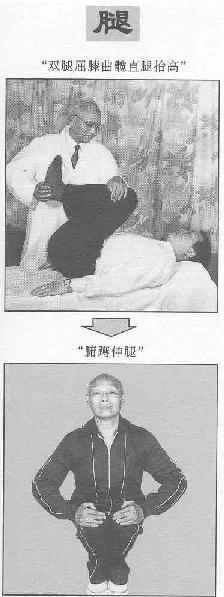 From 1975 until 1983, Dr. Zhuang with the help of other physicians conducted a study applying Liangong in 18 forms in isolation or in some cases accompanied by other methods of traditional Chinese methods (acupuncture, herbs, and massage) to treat three different control groups of patients.
From 1975 until 1983, Dr. Zhuang with the help of other physicians conducted a study applying Liangong in 18 forms in isolation or in some cases accompanied by other methods of traditional Chinese methods (acupuncture, herbs, and massage) to treat three different control groups of patients.
Each of the three groups were then subdivided into three sub groups as follows: Patients who suffered from a) acute pain in the neck, shoulders, back, and legs; b) acute pain or stiffness in the joints and tendons; and c) internal organ discomfort (i.e. heart problems, high blood pressure, digestive disorders, etc.).Prior to the study most all of these patients had a variety interventions performed on them, including surgery, prior to their exposure to Liangong in 18 forms. In most cases, these interventions had only been partially or completely unsuccessful. So, Liangong was yet "another thing" or a last chance hope for many members of all the control groups in overcoming their invariable struggle with pain.
The results were grouped as follows: Those who dropped out and did not complete the study; Those who had no results; Those who had adequate results; Those who had good results; and, those who met with excellent results. The patients who reported feeling an improvement in mobility or a significant reduction of pain were classified as adequate. Those who claimed an alleviation of pain, but within a moderate duration of time, up to two years, after the study had a recurrence of pain(even those who felt that the practice of Liangong could still alleviate the pain) were classified as having good results. Excellent results were recorded for patients who had a total alleviation of their problem, and no recurrence of pain whatsoever over a two year period.
The first control group consisted of 71 patients who were treated with Acu-Point Massage and Chinese Herbs (both externally and internally), at a frequency of one time for at least thirty minutes every other a day for a duration of 4-8 weeks. The results were as follows: 4 patients did not complete the study (5.6%); 2 patients had no result (2.8%); 43 met with adequate results (60.5%); 15 had very good results (21%); and, 7 patients reported excellent results (9.8%).
The second control group was made up of 217 patients. These patients were treated with Acu-Point Massage at a frequency of one time a day every other day for at least thirty minutes, and Liangong exercises (specifically exercises that would address the problem) at a frequency of twice a day for at least thirty minutes each time. Again the treatment period lasted 4-8 weeks for each patient with the following results: 0 patients did not complete the study; 7 patients had no result (3.2%); 102 met with adequate results (47%); 59 had very good results (27.1%); and, 49 patients reported excellent results (22.5%).
The third control group consisted of 1,361 patients who were treated with Liangong exercises (that addressed their problem area) exclusively. The frequency of treatment was once to twice day for at least thirty minutes ranging in duration from two to four months for each patient with the following results: All patients completed the program; 24 had no results whatsoever (1.76%); 814 met with adequate results (59.8%); 523 met with good results (38.4%); and, 0 Had excellent results.
Although no excellent results were reported for the third control group that practiced Liangong exclusively, 98.2% had adequate to good results recorded. These early studies not only helped some patients to better manage their pain, but helped Dr. Zhuang develop the exercises to be more specific in dealing with the often complex injuries associated with both external and internal trauma resulting from the break down of these sensitive areas of the body as a result of living in the modern age.
Since then other studies have been conducted on the effects of Liangong. One study conducted by Dr. Zhuang and the Liangong Shibafa (18 forms) Association of Shanghai recorded a savings of 55, 850 Yuan for pain medication for 42 patients who were able to give up their medication with Liangong. This may not add up to big savings in the average American hospital. However, for reference, the elderly spend a minimum of 500 Yuan annually for routine care in a Chinese hospital. Another in-depth study, conducted in Japan, found that 73 out of 152 persons tested who practiced Liangong to alleviate external pain and stress met with excellent results. 65 of those who met with excellent results also reported feeling more energy after practicing and a greater flexibility in their joints.
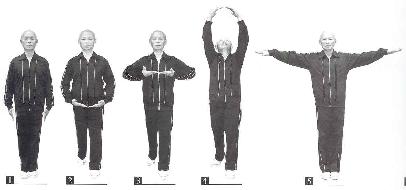
PRECISE MOVEMENTS
Dr. Zhuang has used the postures of the exercises themselves as postures for massage, and to gently apply pressure to the patient's target area for results. However, through the years of testing, Dr. Zhuang has become more and more convinced that Liangong's effects are longer lasting when the practitioner moves their own body by them self. As the practitioner practices the form they them self benefit from the process as well as what each exercise does for them. Zhuang Jian Shen, Dr. Zhuang's son and inheritor of his father's healing arts and practice, says that when a practitioner is able to develop their own skill and heal them self, they are both mentally and physically stronger. Students, who may have once been a patient, once trained correctly in the complete application and methods of Liangong are then able to lay hands on to heal. Hands on healing doesn't necessarily mean massage, but by correcting the postures of the students, they are able to help other practitioners optimize their movements for greater benefit.
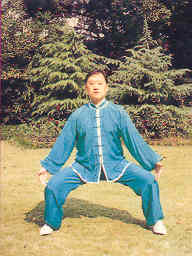 When the movements are practiced correctly, the practitioner should sense an internal force or resistance. This does not mean that internal force is confined to a psychological process only, or that something is done with a lack of force. Rather, specific movements are able to isolate certain joints or target areas, and when accompanied by slow, deliberate motion can be much more exact. The character of internal force comes when the practitioner is able to isolate their joints and use natural forces such as gravity and momentum to exercise or release stress from their joints.
When the movements are practiced correctly, the practitioner should sense an internal force or resistance. This does not mean that internal force is confined to a psychological process only, or that something is done with a lack of force. Rather, specific movements are able to isolate certain joints or target areas, and when accompanied by slow, deliberate motion can be much more exact. The character of internal force comes when the practitioner is able to isolate their joints and use natural forces such as gravity and momentum to exercise or release stress from their joints.
That's why, according to Dr. Zhuang, the theory of massage plays an important role in how Liangong is practiced. Traditional Chinese massage holds that the key element in massage begins with the various manipulations of specific aspects or parts of the body. Manipulation must be gentle, even, forceful and persistent, so as to achieve a penetrating action. This penetrating effect is what the practitioner should feel as a reaction to the practice of Liangong. In other words, "a good sore." In Dr. Zhuang's research a muscle is made up of many contractible fibers. There are many nerve endings in the muscles; those controlling the contraction of muscles are called motor nerve endings, each of which controls 100 to 300 muscular fibers. Each nerve ending and the muscular fibers it controls make a motor unit, and there are many motor units in a muscle, which are not all in a state of excitation and contraction at a given time. With a change of movement, these two types of motor units change too. The contracted fibers become shortened while the relaxed fibers lengthen.
 This is why at the beginning of each of the postures there may be a tightness exerted by the practitioner, followed by a preparatory movement added while maintaining some of the tightness or force. Then the practitioner turns into an isolated area to apply pressure on this given area. That which was locked is then relaxed, to enable a more beneficial stretch during a twist or turn, or to create a more stable position to turn or move into. Then often the chest is lifted, to create a more internal stretch. Ultimately creating a climate for change among participating nerve fibers, and releasing stress at specific points.
This is why at the beginning of each of the postures there may be a tightness exerted by the practitioner, followed by a preparatory movement added while maintaining some of the tightness or force. Then the practitioner turns into an isolated area to apply pressure on this given area. That which was locked is then relaxed, to enable a more beneficial stretch during a twist or turn, or to create a more stable position to turn or move into. Then often the chest is lifted, to create a more internal stretch. Ultimately creating a climate for change among participating nerve fibers, and releasing stress at specific points.
Correct breathing is also extremely important. But as outlined in his books when in doubt breathe naturally and never hold the breath. However, he advocates when the student is able to, inhaling in the first movement (which is often a tight time), and exhaling when moving into the target area (usually the relaxed time) as the most optimum. Furthermore, Dr. Zhuang recommends, as I eluded to earlier, lifting the chest cavity when inhaling and exhaling from the lower abdomen. This lifting of the chest cavity keeps a constant stimulation on the internal organs, which in turn creates a natural resistance. Dr. Zhuang compares this natural resistance, much the way water creates a buoyancy and can be applied for deep penetration in water massage. Furthermore, Dr. Zhuang feels practicing out of doors early in the morning in the fresh air is viable and will naturally make warmth and comfort positive modalities that can further optimize the therapeutic success of Liangong.
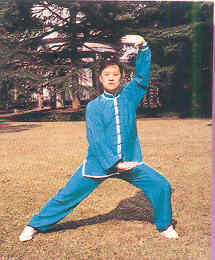 When practicing, Dr. Zhuang says that the range of movements are also important to Liangong's success. The larger the movements from the joints and limbs, the more beneficial the results. However, the parts of the body that remain still as to isolate specific points, joints, connective tissue, or muscle groups must be strictly adhered to or the parts that emphasize the movement will be wasted. Furthermore, such unfocused exercise would ignore the scientific development and testing, which is the basis of Liangong's existence.
When practicing, Dr. Zhuang says that the range of movements are also important to Liangong's success. The larger the movements from the joints and limbs, the more beneficial the results. However, the parts of the body that remain still as to isolate specific points, joints, connective tissue, or muscle groups must be strictly adhered to or the parts that emphasize the movement will be wasted. Furthermore, such unfocused exercise would ignore the scientific development and testing, which is the basis of Liangong's existence.
Like martial arts, patience and perseverance are important in Liangong practice. Dr. Zhuang advocates practicing at regular hours and on a daily basis. According to Dr. Zhuang, sports practitioners who are aware of the benefits of Liangong, often utilize the exercises to effectively warm up the body before beginning a competition or intensive training. Dr. Zhuang has overseen the effective application of Liangong for stress reduction in the workplace both in China and Japan. While Liangong has been applied successfully in the workplace, Dr. Zhuang's observation of Liangong for stress reduction or to overcome injuries have as many differences as there are similarities.
While the practice of Liangong can show immediate effects in stress reduction, injuries can take a long period of time to heal, and it is perseverance that helps the injured move towards alleviating the problem and returning to their everyday life. Likewise, while stress relief may be an immediate byproduct of practice, stress will continue to recur until they practice more regularly. Furthermore, while Liangong can be an effective supplement to comprehensive medical treatment, the effect of Liangong depends on each patient’s desire to completely restore bodily functions.
AN INTERNATIONAL AFFAIR
Liangong's popularity is growing world-wide. For the past eight years, Liangong organizations internationally have come together for a lavish event every other year. Novices as well as long time practitioners of Liangong are invited to attend, observe, or participate in various events. This international convention consists of demonstrations in a wide variety of cultural arts that often include an opening ceremony, a competition which focuses on precision of movement as well as health benefits from practice, and an international closing party that features a wide array of multicultural flavor. All in all, most participants come to have a deeper understanding of the true, specific practice of Liangong, and the opportunity to make new international friends. Ultimately, Dr. Zhuang feels that more rigorous testing is needed. Since he first started his research more than 25 years ago, he and many others have become more aware of the infinite applications exercise has in treating stress and injury. The future of Liangong, according to Dr. Zhuang, lies in the process of the practitioner them self realizing the infinite power the body and mind have, and a constant reflection on the effectiveness and application of exercise as a vehicle for self healing.
For additional information visit the Liangong website
For information about our comprehensive Liangong Book and Video Combo click here.
For information on Private Lessons and Long Distance Learning click here, or contact Gerald A. Sharp at: chiflow@earthlink.net
Â
